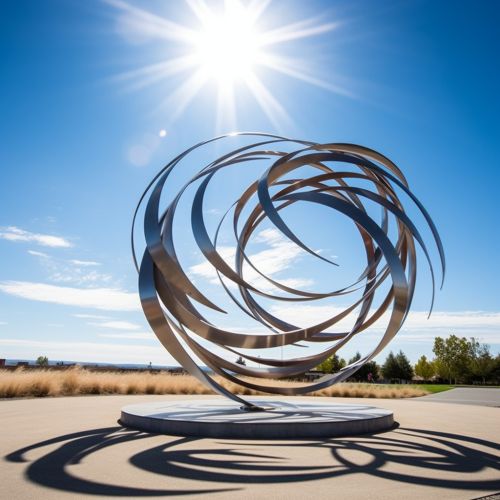Kinetic Sculpture in Art and Engineering
Introduction
Kinetic sculpture, a form of art that depends on motion for its effects, has been a significant part of the art and engineering fields for centuries. These sculptures, which can be powered by wind, motor or human interaction, offer a dynamic and interactive element that static sculptures cannot provide. The integration of engineering principles with artistic vision in the creation of kinetic sculptures has led to some of the most innovative and captivating works of art in history.
History
The concept of kinetic sculpture can be traced back to the early 20th century, with artists like Naum Gabo and Alexander Calder pioneering the movement. Gabo's "Standing Wave" (1919-20) is often considered the first true kinetic sculpture, using a vibrating wire to create the illusion of movement. Calder, on the other hand, is known for his mobiles, delicate, balanced sculptures that move with the air currents.
Principles of Kinetic Sculpture
The creation of kinetic sculptures involves a deep understanding of both art and engineering principles. Artists must not only be able to envision and design the aesthetic aspects of the sculpture, but also understand the mechanical and physical principles that will allow their sculpture to move.
Balance
Balance is a critical aspect of many kinetic sculptures, especially those that are designed to move with the wind or through human interaction. Artists must carefully consider the weight distribution of their sculpture, ensuring that it is balanced enough to move as intended without toppling over.
Motion
The motion of a kinetic sculpture is its defining feature. This motion can be achieved through a variety of means, including wind, motors, or human interaction. The type of motion can greatly affect the overall effect of the sculpture, with some artists opting for smooth, flowing movements, while others prefer more erratic, unpredictable motion.
Materials
The materials used in kinetic sculptures can vary widely, from traditional sculpting materials like metal and wood, to more unconventional materials like plastic or recycled items. The choice of material can greatly affect the weight, durability, and movement of the sculpture.
Notable Kinetic Sculptors
There are many artists who have made significant contributions to the field of kinetic sculpture. These artists have pushed the boundaries of what is possible with motion and sculpture, creating works that are as technically impressive as they are artistically beautiful.
George Rickey
George Rickey was an American kinetic sculptor best known for his large, outdoor kinetic sculptures. His works, often made of stainless steel, are designed to move with the wind, creating a dynamic and ever-changing viewing experience.
Jean Tinguely
Jean Tinguely was a Swiss artist known for his kinetic sculptures made from scrap metal and machinery. His works, which often featured complex mechanical systems, were designed to self-destruct, challenging traditional notions of art and permanence.
Theo Jansen
Theo Jansen is a Dutch artist known for his Strandbeests, large kinetic sculptures that move with the wind. These sculptures, which are made from PVC pipes and other lightweight materials, are designed to mimic the movements of living creatures.
Kinetic Sculpture in Engineering
While kinetic sculpture is often seen as a form of art, it also has significant applications in the field of engineering. Engineers often use principles of kinetic sculpture in their designs, creating structures and machines that are not only functional, but also aesthetically pleasing.
Architecture
Kinetic principles are often used in architecture, with buildings designed to move and change in response to their environment. This can include buildings that rotate to follow the sun, or facades that move to improve ventilation or light penetration.
Robotics
The field of robotics also draws heavily from kinetic sculpture, with robots often designed to mimic the movements of humans or animals. This can include robots that walk or run, or robotic arms that move in a similar way to human arms.
Renewable Energy
Kinetic sculpture principles are also used in the design of renewable energy systems, such as wind turbines. These turbines, which are essentially large kinetic sculptures, are designed to capture the energy of the wind and convert it into electricity.
Conclusion
Kinetic sculpture, with its combination of art and engineering, offers a unique and dynamic form of artistic expression. Whether it's a delicate mobile moving with the breeze, a massive outdoor sculpture swaying in the wind, or a complex machine designed to self-destruct, kinetic sculpture continues to captivate and inspire with its endless possibilities for movement and change.
See Also


